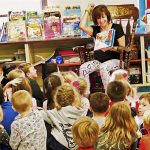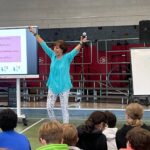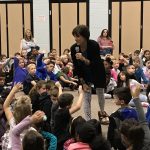LET’S SHARE A STORY TOGETHER!
Suggested audiences: PreK 3 – PreK 4
Program length: 30 minutes
During this classroom “circle” time presentation, I talk very briefly about being an author. We look at several types of picture books, discuss how they are alike and different, and explore the parts of, and the care of, a book. After an introduction to the five senses, children are encouraged to think about what they might see, hear, smell, feel, and taste in the storyline of one of my books. We do several fingerplays and songs; clap out the rhythm and chat about the rhyme, and of course, read! Kids are encouraged to talk about their favorite books and ask questions as they begin a coloring sheet. For this program and all others, teachers can follow up with ELA and STEM activities from the FREE guide listed on this site.
LET’S PLAY WITH WORDS!
Suggested audiences: Grades K – 1
Program length: 45 minutes
What was I like as a child and did my childhood influence my writing? What is my day-to-day author life like? Where’s my office? Am I the author or illustrator or both? Why do I think about the parts of a picture book and the five senses when I’m writing? How important is it to pick the perfect word to describe what’s going on?
After a short introduction to how and why I became an author, we take a close look at unusual words in several picture books. Following a review of the five senses and how all the senses are engaged when reading and writing, students interact with rhyming phrases and see why each word (a rhyming word, a sound word, or a silly one) is important to the story. With sound and movement, there is never a dull moment! A book trailer adds a musical component, and the kids have the opportunity to practice reading a few of the new words they’ve learned. Finally, it’s time for lots of audience involvement as one picture book is read in its entirety. Questions are encouraged!
ROCK THE RHYME AND RHYTHM IN YOUR READING AND WRITING!
Suggested audiences: Grades 2 – 3 
Program length: One hour
What was I like as a child and did my childhood influence my writing? What is my day-to-day author life like? What does my office look like? Am I an author or an author-illustrator? How important is it to include rhyme and rhythm?
This program begins the same as the one above; however, it is longer and goes into more depth. Students learn about the very first book I penned as a child, what inspires me, and what my writing space looks like. With a focus on picture books, I highlight tips that students can use as they read and write. While interacting with sensory details, descriptive adjectives, active verbs, onomatopoeia, rhyme, and rhythm, kids discover how each word is important in a story. Volunteers become Super-Duper Fixer-Uppers (editors), and we giggle over the challenges that come with revising. With help from the audience, one book is read out loud as everyone listens for the rhyme and rhythm. Lastly, depending on the reading level of the students or the time of year, we touch on character, plot, and setting, and how these elements in a non-rhyming story contribute to its rhythm. At the end, there is always time for questions!
STEP INTO MY WRITING WORLD, AND YOURS!
Suggested audiences: Grades 4 – 6
Program length: One hour
What was my very first book? Did I always want to be a writer? What is my process for creating characters, deciding on a setting, and developing a plot? What events have inspired me to take on a new topic? Who helps me revise my work? Why is research important in writing fiction? How do I come up with ideas? What am I working on now?
In this funny and fast-moving presentation geared toward a middle-grade audience, I talk about my journey to publication and give everyone an insider’s view of the writing business. From the point of inspiration to the final draft, students discover the process involved in creating picture books and novels. Picture books and middle-grade novels are highlighted so students get an understanding of the similarities and differences involved in writing a 200-word story vs. a 35,000-word one. They’re put to work as my editors to learn about editing, rewriting, and revision, and how research plays a key part in writing fiction. We explore how to create interesting characters, how characters’ actions and dialogue enhance plot, and how great story ideas can be found in everyday activities. Students get to see my office, hear me read a few chapters or an entire picture book, and get a sneak peek into my next project. Short writing activities are sprinkled throughout the presentation to help even the most antsy kids stay focused and involved. By the end of an hour everyone understands why it takes hard work, patience, and a sense of humor to be a writer.
